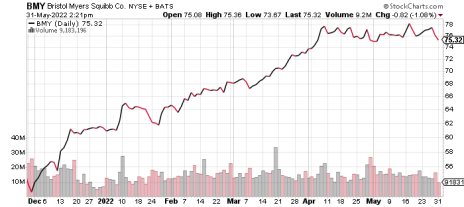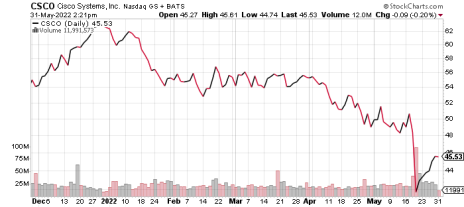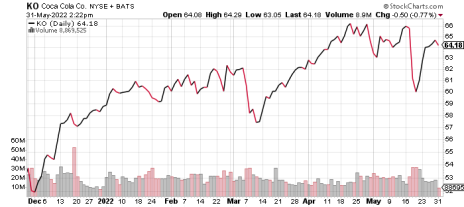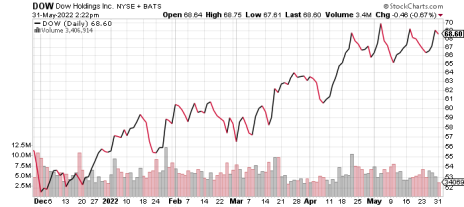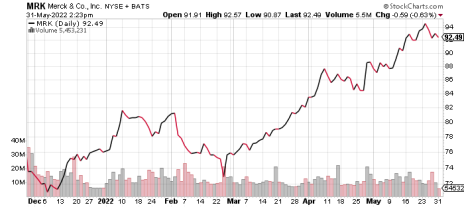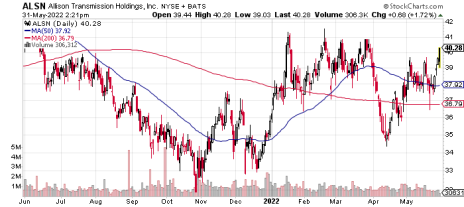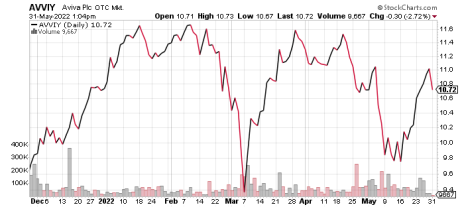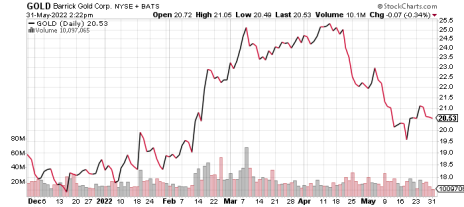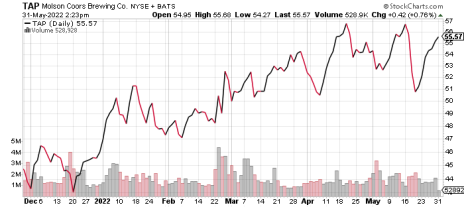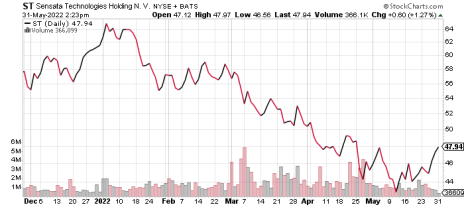As investors are broadly satisfied with the current outlook, it seems that we have arrived at the end of the beginning of the post-pandemic era. However, there remains immense uncertainly about how the middle-game will play out.
This week, we took advantage of the strong performance of some of our stocks to reduce our ratings. And, as not every stock works right out of the gates, we are moving Big Lots (BIG) from Buy to Hold as we want to rethink our outlook and valuation given its dismal recent earnings report.
Cabot Undervalued Stocks Advisor Issue: June 1, 2022
DOWNLOAD ISSUE PDFThe End of the Beginning
It appears that the first step-down in the stock market is over. Investors seem to be sufficiently satisfied with the inflation, recession and interest rate outlook to return to at least some more assertive buying. With this change in attitude, reflected in the quick 8% bounce from the lows of a few weeks ago, it seems that the beginning of the market’s adjustments to the post-pandemic era has been completed.
The middle-game is ahead, and the outcome is of course unknown. We don’t know the course of inflation or its underlying causes, nor do we know the outcome of the war in Ukraine or of any further conflicts that may arise. Every pundit is guessing about the timing, depth and nature of a recession, but this is only guessing as nobody knows for sure. The Fed is waiting on the same data as everyone else, so their program for monetary tightening depends on the same unknowns.
Following a market bounce, it’s easier to get more confident in its direction. But, no one called the top, and no one is going to call the bottom either. All we can do is keep some powder dry as we buy some names that look cheap (not just cheaper than they were, but actually inexpensive) and have solid enough fundamentals.
So much is changing so quickly that it is easy, even for veterans, to make mistakes. While it is too early to say for sure, our recent recommendation of Big Lots (BIG) has clearly gone south in a hurry. We are moving this stock to a Hold until we can dive in deeply to better understand what happened in the quarter and better evaluate its risk/return tradeoff from here.
We are also taking this opportunity to capture our profits in Bristol-Myers Squibb (BMY), which has been a solid performer on the back of its strong fundamentals and low valuation.
Share prices in the table reflect Tuesday (May 31) closing prices. Please note that prices in the discussion below are based on mid-day May 31 prices.
Note to new subscribers: You can find additional color on past earnings reports and other news on recommended companies in prior editions and weekly updates of the Cabot Undervalued Stocks Advisor on the Cabot website.
Send questions and comments to Bruce@CabotWealth.com.
Today’s Portfolio Changes
Bristol-Myers Squibb (BMY) – Moving from HOLD to SELL.
Big Lots (BIG) – Moving from BUY to HOLD.
Portfolio changes during the past month
The Coca-Cola Company (KO) – Moving from BUY to HOLD.
Merck & Company (MRK) – Moving from BUY to HOLD.
Bristol-Myers Squibb (BMY) – Moving rating from BUY to HOLD.
A
Growth & Income
Portfolio
Growth & Income Portfolio stocks are generally higher-quality, larger-cap companies that have fallen out of favor. They usually have some combination of attractive earnings growth and an above-average dividend yield. Risk levels tend to be relatively moderate, with reasonable debt levels and modest share valuations.
| Growth/Income Portfolio | |||||||
| Stock (Symbol) | Date Added | Price Added | 5/31/22 | Capital Gain/Loss | Current Dividend Yield | Price Target | Rating |
| Bristol-Myers Squibb (BMY) | 04-01-20 | 54.82 | 75.16 | 37.1% | 2.9% | 78.00 | SELL |
| Cisco Systems (CSCO) | 11-18-20 | 41.32 | 45.46 | 10.0% | 3.3% | 66.00 | Buy |
| Coca-Cola (KO) | 11-11-20 | 53.58 | 64.09 | 19.6% | 2.6% | 69.00 | Hold |
| Dow Inc (DOW) * | 04-01-19 | 53.50 | 68.59 | 28.2% | 4.1% | 78.00 | Buy |
| Merck (MRK) | 12-9-20 | 83.47 | 92.32 | 10.6% | 3.0% | 99.00 | Hold |
| Current price | Current 2022 EPS Estimate | Current 2023 EPS Estimate | Change in 2022 Estimate | Change in 2023 Estimate | P/E 2022 | P/E 2023 | |
| BMY | 74.98 | 7.62 | 8.20 | -0.1% | 0.1% | 9.8 | 9.1 |
| CSCO | 45.09 | 3.36 | 3.56 | 0.0% | 0.0% | 13.4 | 12.7 |
| KO | 63.75 | 2.47 | 2.65 | 0.0% | 0.0% | 25.8 | 24.1 |
| DOW | 68.14 | 8.12 | 7.33 | -1.2% | -0.1% | 8.4 | 9.3 |
| MRK | 91.81 | 7.38 | 7.41 | 0.0% | -0.4% | 12.4 | 12.4 |
CSCO: Estimates are for fiscal years ending in July
*Note: DOW price is based on April 1, 2019 closing price following spin-off from DWDP.
Bristol-Myers Squibb Company (BMY) shares sell at a low valuation due to worries over patent expirations for Revlimid (starting in 2022) and Opdivo and Eliquis (starting in 2026). However, the company is working to replace the eventual revenue losses by developing its robust product pipeline while also acquiring new treatments (notably with its acquisitions of Celgene and MyoKardia), and by signing agreements with generics competitors to forestall their competitive entry. The likely worst-case scenario is flat revenues over the next 3-5 years. Bristol should continue to generate vast free cash flow, has a solid, investment-grade balance sheet, and trades at a sizeable discount to its peers.
There was no significant company-specific news in the past week.
This past week, BMY shares fell 3%. Since our recent move to a Hold rating, the shares have slipped a tad – our expectation that its upward momentum would allow us to squeeze just a bit more out of this name hasn’t come to pass. So, we are staying with our price target discipline and exiting the BMY position by moving the shares to a Sell.
The position produced an approximate 36% total return since the current analyst began coverage in July 2020 and an approximate 47% total return since the initial recommendation in April 2020. SELL
Cisco Systems (CSCO) is facing revenue pressure as customers migrate to the cloud and thus need less of Cisco’s equipment and one-stop-shop services. Cisco’s prospects are starting to improve under a relatively new CEO, who is shifting Cisco toward a software and subscription model and is rolling out new products, helped by its strong reputation and entrenched position within its customers’ infrastructure. The company is highly profitable, generates vast cash flow (which it returns to shareholders through dividends and buybacks) and has a very strong balance sheet.
On May 18, Cisco reported a reasonable quarter but its updated fourth-quarter guidance was light, sending the shares down 14% on the day. The company is usually very reliable with its guidance, so the sell-off reflected more surprise than any meaningful shift in fundamentals, especially as the company’s order book and supply issues seem to be affecting its results. Investors nonetheless worry that a tech spend recession is on the way, which would reduce volumes and prices for Cisco.
In the quarter, adjusted earnings of $0.87/share rose 5% from a year ago and were a penny above the consensus estimate. Revenues were flat compared to a year ago and were 4% below the consensus estimate. Fourth-quarter guidance implies a decline in revenues and profits.
The company blamed the Ukraine war, China’s Covid lockdowns and supply chain issues for the weaker revenues and said that these issues will extend into the fourth quarter. Profit margins and thus operating profits will be dragged down, as well. However, the company said that underlying demand remains strong and pointed to the 8% increase in new product orders and the 150% higher backlog compared to a year ago. Perhaps just as telling is that Cisco is able to push through price increases – our view is that customers have little negotiating power and perhaps little motivation to push back on price increases if they need the gear.
So, we are stuck with a stock that has fully round-tripped from our initial recommendation at 41.32 to 64 and back to 45 or so. While frustrating, this is not the time to sell the stock. The fundamentals remain reasonably stable and likely to tick back upward, and profits seem likely to improve as well. If we have a recession in global tech spending, Cisco would likely feel the downturn but not as severely as other technology companies due to the mission-critical nature of its products and services.
There was no significant company-specific news in the past week.
The valuation is attractive at 9.2x EV/EBITDA and 13.4x earnings, the shares pay a sustainable 3.4% dividend yield, the balance sheet is very strong and Cisco holds a key role in the basic plumbing of technology systems even if its growth rate is only modest. We are keeping our Buy rating.
CSCO shares rose 3% in the past week and have 46% upside to our 66 price target. BUY
The Coca-Cola Company (KO) is best-known for its iconic soft drinks yet nearly 40% of its revenues come from non-soda beverages across the non-alcoholic spectrum. Its global distribution system reaches nearly every human on the planet. Coca-Cola’s longer-term picture looks bright, but the shares remain undervalued due to concerns over the pandemic, the secular trend away from sugary sodas, and a tax dispute which could cost as much as $12 billion (likely worst-case scenario). The relatively new CEO James Quincey (2017) is reinvigorating the company by narrowing its oversized brand portfolio, boosting its innovation and improving its efficiency, as well as improving its health and environmental image. Coca-Cola’s balance sheet is sturdy, and its growth investing, debt service and dividend are well-covered by free cash flow.
There was no significant company-specific news in the past week.
KO shares were flat in the past week and have 8% upside to our recently and tepidly raised 69 price target. We recently moved the shares to a HOLD as rising interest rates and the market’s weakness put a lid on the target valuation multiple.
Coca-Cola’s fundamentals remain sturdy with respectable revenue, profit and free cash flow growth. Management continues to focus on execution in its core business while generally avoiding any major non-core commitments. HOLD
Dow Inc. (DOW) merged with DuPont to create DowDuPont, then split into three companies in 2019 based on product type. The new Dow is the world’s largest producer of ethylene/polyethylene, the most widely used plastics. Investors undervalue Dow’s hefty cash flows and sturdy balance sheet largely due to its uninspiring secular growth traits, its cyclicality and concern that management will squander its resources. The shares are driven by: 1) commodity plastics prices, which are often correlated with oil prices and global growth, along with competitors’ production volumes; 2) volume sold, largely driven by global economic conditions; and 3) ongoing efficiency improvements (a never-ending quest of all commodity companies). We see Dow as having more years of strong profits before capacity increases signal a cyclical peak, and expect the company to continue its strong dividend, reduce its pension and debt obligations, repurchase shares slowly and restrain its capital spending.
Industry conditions will likely be strong for a while. Dow remains well-positioned to generate immense free cash flows over the next few years, even as the stock market cares little about cash but rather is focused on the incremental news flow related to economic growth, energy prices and any industry capacity changes. In the meantime, Dow shareholders can collect a highly sustainable 4.1% dividend yield while waiting for more share buybacks, more balance sheet improvement, more profits and a higher valuation.
Dow has several headwinds, including potential pricing pressure from new supply in a year or so, rapidly rising natural gas input prices, a complicated demand situation in China, and to some degree reliance on high oil prices for its pricing power. The shares have been strong this year, in a difficult market, and continue to have strong dividend support, but the upside from our perspective is probably capped around our price target. No change to our price target or rating.
There was no significant company-specific news in the past week.
Dow shares ticked up 2% in the past week and have 14% upside to our 78 price target. BUY
Merck (MRK) shares are undervalued as investors worry about Keytruda, a blockbuster oncology treatment (about 30% of revenues) which faces generic competition in late 2028. Also, its Januvia diabetes treatment may see generic competition next year, and like all pharmaceuticals it is at risk from possible government price controls. Yet, Keytruda is an impressive franchise that is growing at a 20% rate and will produce solid cash flow for nearly seven more years, providing the company with considerable time to replace the potential revenue loss. Merck’s new CEO, previously the CFO, is accelerating Merck’s acquisition program, which adds return potential and risks to the story. The company is highly profitable and has a solid balance sheet. It spun off its Organon business last June and we think it will divest its animal health segment sometime in the next five years.
There was no significant company-specific news in the past week.
Merck shares slipped 3% in the past week and have about 8% upside to our 99 price target. The company has a strong commitment to its dividend (2.8% yield) which it backs up with generous free cash flow, although its shift to a more acquisition-driven strategy will slow the pace of dividend increases. With limited upside, and our reluctance to raise our price target, we recently moved the shares to HOLD. HOLD
Buy Low Opportunities
Portfolio
Buy Low Opportunities Portfolio stocks include a wide range of value opportunities, often with considerable upside. This group may include stocks across the quality and market cap spectrum, including those with relatively high levels of debt and a less-clear earnings outlook. The stocks may not pay a dividend. In all cases, the shares will trade at meaningful discounts to our estimate of fair value.
| Buy Low Opportunities Portfolio | |||||||
| Stock (Symbol) | Date Added | Price Added | 5/31/22 | Capital Gain/Loss | Current Dividend Yield | Price Target | Rating |
| Allison Transmission Hldgs (ALSN) | 02-22-22 | 39.99 | 40.15 | 0.4% | 2.1% | 48.00 | Buy |
| Arcos Dorados (ARCO) | 04-28-21 | 5.41 | 7.82 | 44.5% | 1.9% | 8.50 | Buy |
| Aviva (AVVIY) | 03-03-21 | 10.75 | 10.72 | -0.3% | 7.7% | 14.00 | Buy |
| Barrick Gold (GOLD) | 03-17-21 | 21.13 | 20.54 | -2.8% | 1.9% | 27.00 | Buy |
| BigLots (BIG) | 04-12-22 | 35.24 | 25.26 | -28.3% | 4.8% | 45.00 | Hold |
| Citigroup (C) | 11-23-21 | 68.10 | 53.48 | -21.5% | 3.8% | 85.00 | Buy |
| Molson Coors (TAP) | 08-05-20 | 36.53 | 55.40 | 51.7% | 2.5% | 69.00 | Buy |
| Organon (OGN) | 06-07-21 | 31.42 | 38.13 | 21.4% | 2.9% | 46.00 | Buy |
| Sensata Technologies (ST) | 02-17-21 | 58.57 | 47.91 | -18.2% | 0.9% | 75.00 | Buy |
| Current price | Current 2022 EPS Estimate | Current 2023 EPS Estimate | Change in 2022 Estimate | Change in 2023 Estimate | P/E 2022 | P/E 2023 | |
| ALSN | 39.95 | 6.24 | 7.21 | 0.0% | 0.0% | 6.4 | 5.5 |
| ARCO | 7.71 | 0.39 | 0.46 | 0.0% | 0.0% | 19.8 | 16.8 |
| AVVIY | 10.69 | 1.21 | 1.51 | 0.3% | 0.8% | 8.8 | 7.1 |
| BIG | 25.14 | (2.27) | 2.91 | -150.2% | -45.5% | (11.1) | 8.6 |
| GOLD | 20.65 | 1.16 | 1.20 | 1.3% | 0.7% | 17.8 | 17.2 |
| C | 53.53 | 6.83 | 7.37 | 0.0% | 0.0% | 7.8 | 7.3 |
| TAP | 54.89 | 3.93 | 4.28 | 0.0% | 0.0% | 14.0 | 12.8 |
| OGN | 37.96 | 5.33 | 5.74 | 0.0% | 0.0% | 7.1 | 6.6 |
| ST | 47.66 | 3.88 | 4.54 | 0.0% | 0.0% | 12.3 | 10.5 |
Current price is yesterday’s mid-day price.
Allison Transmission Holdings, Inc. (ALSN) – Allison Transmission is a mid-cap ($6.4 billion market cap) manufacturer of vehicle transmissions. Many investors view this company as a low-margin producer of car and light truck transmissions that is destined for obscurity in an electric vehicle world. However, Allison produces no car and light truck transmissions, instead it focuses on the school bus and Class 6-8 heavy-duty truck categories, where it holds an 80% market share. Its 35% EBITDA margin is sharply higher than its competitors and on par with many specialty manufacturers. And, it is a leading producer and innovator in electric axles which all electric trucks will require. Another indicator of its advanced capabilities: Allison was selected to help design the U.S. Army’s next-generation, electric-powered vehicle. The company generates considerable free cash flow and has a low-debt balance sheet. Its capable leadership team keeps its shareholders in mind, as the company has reduced its share count by 38% in the past five years.
There was no significant company-specific news in the past week.
Allison shares jumped 6% in the past week and have 20% upside to our 48 price target. The stock pays an attractive and sustainable 2.1% dividend yield to help compensate for the wait. BUY
Arcos Dorados (ARCO), which is Spanish for “golden arches,” is the world’s largest independent McDonald’s franchisee. Based in stable Uruguay and listed on the NYSE, the company produces about 72% of its revenues in Brazil, Mexico, Argentina and Chile. The shares are depressed as investors worry about the pandemic, as well as political/social unrest, inflation and currency devaluations. However, the company has a solid brand and high recurring demand and is well-positioned to benefit as local economies re-open. The leadership looks highly capable, led by the founder/chairman who owns a 38% stake, and has the experience to successfully navigate the complex local conditions. Debt is reasonable relative to post-recovery earnings, and the company is currently producing positive free cash flow.
Macro issues, including issues in Brazil related to its economic conditions (in particular, inflation, running at a 11.3% rate), currency and the chances that a socialist might win this year’s Brazilian presidential elections, will continue to move ARCO shares.
On May 18, Arcos reported an impressive first quarter, with net income of $0.12/share compared to a $(0.13)/share loss a year ago and the consensus estimate of $0.08/share. Revenues rose 41% and were 8% above the consensus estimate. On a same-store basis, sales rose 42% compared to a year ago. Adjusted EBITDA of $80 million set a first-quarter record and trailing 12-month adjusted EBITDA was the highest in the company’s history. Arcos is benefitting from the post-pandemic reopening but also considerable self-help as its profit margins expanded despite numerous headwinds. All-in, the Arcos recovery is strong and poised to continue.
There was no significant company-specific news in the past week.
ARCO shares gained 4% in the past week and have 10% upside to our recently increased 8.50 price target. BUY
Aviva, plc (AVVIY), based in London, is a major European company specializing in life insurance, savings and investment management products. Amanda Blanc was hired as the new CEO in July 2020 to revitalize Aviva’s laggard prospects. She divested operations around the world to re-focus the company on its core geographic markets (U.K., Ireland, Canada), and is improving Aviva’s product competitiveness, rebuilding its financial strength and trimming its bloated costs. Aviva’s dividend has been reduced to a more predictable and sustainable level with a modest upward trajectory. Excess cash balances are being directed toward debt reduction and potentially sizeable special dividends and share repurchases.
Much of our interest in Aviva is based on its plans for returning its excess capital to shareholders, including share repurchases and dividends. These distributions could be substantial. We also look for incremental shareholder-friendly pressure from highly regarded European activist investor Cevian Capital, which holds a 5.2% stake.
The consensus earnings estimates remained steady this week.
Aviva shares were flat in the past week and have about 31% upside to our 14 price target. Based on management’s estimated dividend for 2023 (which we believe is highly credible), the shares produce a generous 7.8% yield. Based on this year’s actual dividend, the shares offer an attractive 5.0% dividend yield. BUY
Barrick Gold (GOLD), based in Toronto, is one of the world’s largest and highest-quality gold mining companies. About 50% of its production comes from North America, with the balance from Africa/Middle East (32%) and Latin America/Asia Pacific (18%). Barrick will continue to improve its operating performance (led by its new and highly capable CEO), generate strong free cash flow at current gold prices, and return much of that free cash flow to investors while making minor but sensible acquisitions. Also, Barrick shares offer optionality – if the unusual economic and fiscal conditions drive up the price of gold, Barrick’s shares will rise with it. Given their attractive valuation, the shares don’t need this second (optionality) point to work – it offers extra upside. Barrick’s balance sheet has nearly zero debt net of cash. Major risks include the possibility of a decline in gold prices, production problems at its mines, a major acquisition and/or an expropriation of one or more of its mines.
There was no significant company-specific news in the past week.
Over the past week, commodity gold ticked down about 1% to $1,844/ounce. The 10-year Treasury yield jumped to 2.85%. The spread between this yield and inflation of 8.5% remains exceptionally wide compared to a long-term average spread of perhaps one to two percentage points, strongly suggesting many more interest rate hikes ahead. Chatter about the “real” yield turning positive is based on other yields and inflation rates and we consider them to be less useful. The U.S. Dollar Index, another driver of gold prices (the dollar and gold usually move in opposite directions), was unchanged at 101.82.
Barrick shares slipped 3% in the past week and have about 31% upside to our 27 price target. The price target is based on 7.5x estimated steady-state EBITDA and a modest premium to our estimate of $25/share of net asset value. BUY
Big Lots (BIG) – Big Lots is a discount general merchandise retailer based in Columbus, Ohio, with 1,431 stores across 47 states. Its stores offer an assortment of furniture, hard and soft home goods, apparel, electronics, food and consumables as well as seasonal merchandise. The company has a large and loyal customer base of 22 million Rewards program members, which has growth steadily over the past decade. Big Lots should benefit if consumers trade down due to a slowing and inflationary economy. While low, the 5.5% cash operating profit margin appears stable. We are intrigued enough by the shares’ remarkably low valuation to make this stock a Hold. On conservative fiscal 2022 (ending in January 2023) estimates, the shares currently trade at 3.1x EV/EBITDA and 7.3x per-share earnings. These multiples imply a dour recessionary future for the company. The EV/EBITDA multiple is sharply below an average of perhaps 5x-9x for its peers. Even adjusting for scale and quality, a discount of this size for BIG is unwarranted. Big Lots’ shares trade unchanged from their 2007 price level and are down 50% from their stimulus-boosted peak at over 70 last year. Activist investor Mill Road Capital (5.1% stake) recently highlighted the shares’ deeply discounted valuation. All-in, while BIG shares carry higher risk, the risk/return trade-off appears compelling.
On May 27, Big Lots reported dismal results. The company reported a loss of $(0.39)/share compared to $2.62/share profit a year ago. The results were awful even when compared to the company’s guidance of $1.10-$1.20 and to the $0.94 consensus estimate. Revenues fell 15% from a year ago and were about 6% below the consensus. Big Lots did not provide forward guidance, given “an atypically wide range of outcomes.” The shares tumbled on the news and are now 23% below the price at our recommendation date. This stock and company have been among the worst starts out of the gates for this newsletter in a long time. With the news, we want to rethink this company’s future prospects and valuation. Until we complete this examination, we are moving the shares to a HOLD.
While the year-over-year revenue comparison was weak, the fall-off mostly unwound the post-pandemic surge. On a three-year basis (compared to 2019), revenues were 6% higher, much of which was from same-store sales. Big Lots is suffering as its consumers are pulling back due to higher gasoline prices and inflation in general. The company said that May results were stronger, as the company is aggressively adjusting its pricing, boosting its value offerings, and capitalizing on new close-out opportunities by buying unwanted merchandise from other retailers with excess inventories. We’ll take the comments on May with a grain of salt for now.
Profits were squeezed by the lower sales volumes as well as by higher supply chain costs and higher overhead and labor costs. Inventories were sharply higher.
Management is working aggressively to address its problems. The company is cutting prices to aggressively offload the inventory glut, which will depress profits in future quarters. As the inventory is sold, Big Lots’ new $271 million in debt should slide lower. The company is also cutting this year’s capital spending from around $220 million to $175 million and accelerating their $70 million cost-cutting program. Access to capital remains strong, and the dividend remains intact.
Big Lots shares fell 4% in the past week and have 79% upside to our 45 price target. HOLD
Citigroup (C) – Citi is one of the world’s largest banks, with over $2.4 trillion in assets. The bank’s weak compliance and risk-management culture led to Citi’s disastrous and humiliating experience in the 2009 global financial crisis, which required an enormous government bailout. The successor CEO, Michael Corbat, navigated the bank through the post-crisis period to a position of reasonable stability. Unfinished, though, is the project to restore Citi to a highly profitable banking company, which is the task of new CEO Jane Fraser.
There was no significant company-specific news in the past week.
We note that the spread between the 90-day T-bill and the 10-year Treasury note, which approximates the drivers behind Citi’s net interest margin, is 1.81%. This spread widened 22 basis points this past week (there are 100 basis points in one percent).
Citi shares rose 2% over the past week and have about 59% upside to our 85 price target. Citigroup investors enjoy a 3.8% dividend yield and perhaps another 3% or more in annual accretion from the bank’s share repurchase program. BUY
Molson Coors Beverage Company (TAP) is one of the world’s largest beverage companies, producing the highly recognized Coors, Molson, Miller and Blue Moon brands as well as numerous local, craft and specialty beers. About two-thirds of its revenues come from the United States, where it holds a 24% market share. Investors worry about Molson Coors’ lack of revenue growth due to its relatively limited offerings of fast-growing hard seltzers and other trendier beverages. Our thesis for this company is straightforward – a reasonably stable company whose shares sell at an overly discounted price. Its revenues are resilient, it produces generous cash flow and is reducing its debt. A new CEO is helping improve its operating efficiency and expand carefully into more growthier products. The company recently reinstated its dividend.
There was no significant company-specific news in the past week.
TAP shares rose 2% in the past week and have about 26% upside to our 69 price target. The stock remains cheap, particularly on an EV/EBITDA basis, or enterprise value/cash operating profits, where it trades at 9.2x estimated 2022 results, still among the lowest valuations in the consumer staples group and below other brewing companies. The 2.8% dividend only adds to the appeal. BUY
Organon & Company (OGN) was recently spun off from Merck. It specializes in patented women’s healthcare products and biosimilars, and also has a portfolio of mostly off-patent treatments. Organon will produce better internal growth with some boost through smart yet modest-sized acquisitions. It may eventually divest its Established Brands segment. The management and board appear capable, the company produces robust free cash flow, has modestly elevated debt and will pay a reasonable dividend. Investors have ignored the company, but we believe that Organon will produce at least stable and large free cash flows with a reasonable potential for growth. At our initial recommendation, the stock traded at a highly attractive 4x earnings.
There was no significant company-specific news in the past week.
OGN shares rose 1% in the past week and have about 21% upside to our 46 price target (using the same target as the Cabot Turnaround Letter). The shares continue to trade at a remarkably low valuation while offering an attractive 3.0% dividend yield. BUY
Sensata Technologies (ST) is a $3.8 billion (revenues) producer of nearly 47,000 highly engineered sensors used by automotive (60% of revenues), heavy vehicle, industrial and aerospace customers. About two-thirds of its revenues are generated outside of the United States, with China producing about 21%. Investors undervalue Sensata’s durable franchise. Its sensors are typically critical components that generally produce high profit margins. As the sensors’ reliability is vital to safely and performance, customers are reluctant to switch to another supplier that may have lower prices but also lower or unproven quality. Sensata has an arguably under-leveraged balance sheet and generates healthy free cash flow. The relatively new CEO will likely continue to expand the company’s growth potential through acquisitions. Electric vehicles are an opportunity as they expand Sensata’s reachable market.
There was no significant company-specific news in the past week.
ST shares rose 5% in the past week and have about 57% upside to our 75 price target. Our price target now looks optimistic in light of the broad market selloff, but we will keep it for now, even as it may take longer for the shares to reach it. BUY
The next Cabot Undervalued Stocks Advisor issue will be published on July 6, 2022.
About the Analyst
Bruce Kaser
Bruce Kaser has more than 25 years of value investing experience in managing institutional portfolios, mutual funds and private client accounts. He has led two successful investment platform turnarounds, co-founded an investment management firm, and was principal of a $3 billion (AUM) employee-owned investment management company.
Previously, he led the event-driven small/midcap strategy for Ironwood Investment Management and was Senior Portfolio Manager with RBC Global Asset Management where he co-managed the $1 billion value/core equity platform for over a decade. He earned his MBA degree in finance and international business from the University of Chicago and earned a Bachelor of Science in finance, with honors, from Miami University (Ohio).
